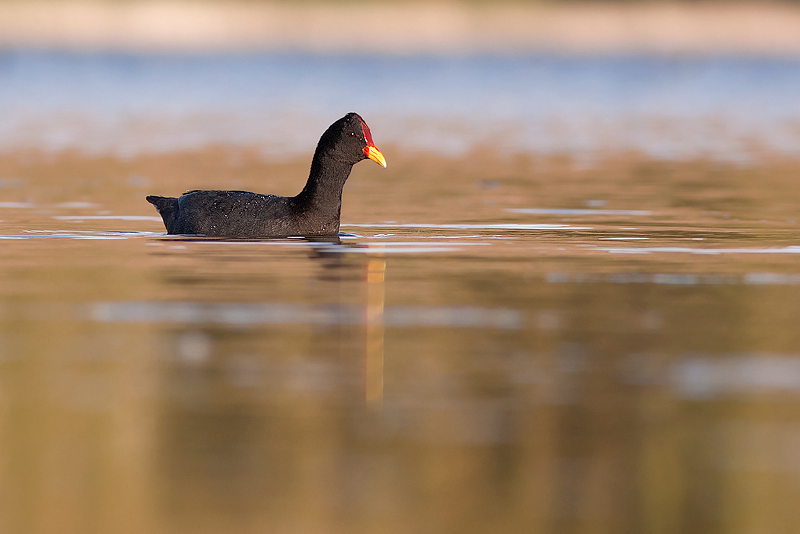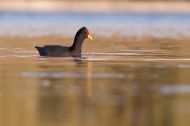Red-fronted Coot
Gallareta de Escudete Rojo
Fulica rufifrons
Length: 390mm. Sexes alike. Bill chrome yellow with upper ridge and sides of base of maxilla and mandible chestnut red; frontal shield thin, long and pointed, chestnut red in colour; iris chestnut; head and neck black; upper back and lesser scapulars dark slate grey; greater scapulars, lower back and uppertail coverts dark olivaceous brown; rectrices blackish brown; breast, flanks and upper abdomen slate grey slightly lighter than upper back; lower abdomen whitish grey; undertail coverts white with black centre; wing coverts slate grey; primaries and secondaries dark brown overall; underwing coverts and axillaries brownish grey. Legs greyish green with a dark green spot at the back in the joint of tibia and tarsus and on joints of toes.
Juvenile plumage is lighter and paler than adult, the shield is much reduced and the bill is blackish brown at the base and yellowish towards the apex; chin, throat and top part of foreneck whitish. Chicks are born with a black down, bare parts of head and bill are brightly coloured; the parts covered with down on the head and neck show the tip of the fine quills yellowish and orange in colour. Special features for identification are its shield for its colour and elongated shape; the upper back, which is olivaceous brown, and longer tail than other members of the Fulica genus. Habitat and behaviour: although not as abundant as other coots, it is fairly common in wetlands, ponds, water ways and streams with dense emergent marshy vegetation and reed beds as well as in flooded grass lands; in our region it used to be found in streams and ponds fringed with willow groves. Habits and customs are similar to its relatives, also in the way it feeds on the water surface or dives to pick various plants, feeding on seeds or grasses on the banks; when it swims it moves its head more often and conspicuously. When flushed it cocks its tail, also flicking it and showing white undertail coverts. The nest is located in reed beds; a floating construction is built which the bird covers by bending surrounding reeds that act as a protective roof. Up to ten eggs are laid, usually six, olivaceous brown with small purple chestnut speckles all over. Very aggressive when defending its territory, openly attacking intruders. Range: widely distributed, it occurs in most of the north of the country; in Patagonia there are sight records from Neuquén and Río Negro to Tierra del Fuego; rare or occasional on Islas Malvinas. On the northwest of Chubut it used to be very common but currently it is very scarce or has disappeared from the area; in the lower valley of the Chubut River, farms at Dolavon, Gaiman and Trelew it used to be found in large flocks along the main irrigation channels. There is only one record on Tierra del Fuego of a specimen found at Estancia Viamonte in 1960. It is worth mentioning that the authors collected a female specimen on November 20, 1980, north of Río Grande in Tierra del Fuego at Estancia Violeta. Apart from Argentina it occurs in Chile, Uruguay and southeast Brazil.
Illustrated Handbook of the Birds of Patagonia
Kindless: Kovacs Family
|









